
Hanging with the makers of Chicago’s modest ethnic cuisines.
This is my tenth ten best list (links to all are at the end of the post) and one that marks a significant change. When I started compiling them a decade ago, it was very much with an eye to advocating the little joints, the ethnic spots, the finds to be found in the urban wilderness (or on trips to areas of regional specialties like Austin). I praised fine dining when it was excellent— Trio under a young fellow named Achatz, Avenues under Bowles, Spring, Moto, Schwa, Blackbird, Vie, beloved departed Mado, Longman & Eagle and Ruxbin all have turned up over the years, among others. But the real point was to call out the wonders of everything from TAC Quick to Burt’s Pizza to Smoque to Sun Wah to Taqueria Ricardo to Taza Bakery to Khan BBQ to Pleasant House… all those little places that everybody knows, now, as part of the fabric of the city.
And now I have a job which is primarily engaged with the world of fine-ish dining, or “chef-driven restaurants” in the too-precious but somehow unimproved-upon phrase, and I get to go to a lot of fine dining places… and guess what, there’s a lot of that on my list. Okay, so I guess that means, middle age happens, you go from one side of the political spectrum to another, from being current with music to satisfied with the oldies, you eat at fewer hot dog stands and more white tablecloth places, right?
Some of that, probably, but I don’t think it’s that easy. The thing that happened to fine dining in this same decade was that it got funkier, realer, more attuned to the things that made that ethnic food great. And the places I really loved this year and thus made this list bridge those two opposites— they make straightforward food rooted in tradition, but because they’re from people with more formal training and expertise, who shop at farmer’s markets and all that stuff, they are faster than the mom and pops to reach the sublime. (Not always— it remains true that a $1.50 taco is nearly always better than a $3 taco in this town— but in the best cases, yes.) So here’s my list, no longer mostly cheap but still, I think, mostly funky; as always, this is stuff new to me this year, don’t assume that I don’t still love Butcher & Larder or whomever:
10. Grilled langoustines, brussel sprout salad, merguez empanada, seafood moqueca, La Sirena Clandestina. I’ve been surprised to see middling reviews for John Manion’s South American place, which scored 4 out of 6 dishes for terrific funky, get-down flavor for me. Maybe there’s some inconsistent execution in a new place, maybe it helped that Manion told me what to order (the middling reviews had none of the above in them except the risotto-like moqueca, which they all praised), but order the list above and if it doesn’t make you happy from the inside out, I don’t know what would. The next night at L2O, as exquisite as some of those seafood creations were… Manion’s charred, funky langoustines kept popping into my head.
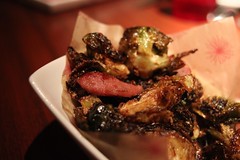

9. Bacon bread, brussels sprouts with kielbasa, Allium. I’ve had other plenty good things at Kevin Hickey’s reinvention of the restaurant in the Four Seasons into a high-end tribute to his south side origins, but these two seem the most iconic because they show off the remarkable trick he pulled off, bringing a pure shot of authentic Chicago (the bacon buns inspired by Bridgeport Bakery, the coarse, porky Polish kielbasa tossed with charred crispy brussels sprouts) into the most generic of environments, the international hotel dining room, and appointing himself the south side’s culinary cultural ambassador in the process.
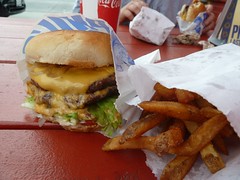
8. Phil’s Last Stand. Phil’s imitation In-N-Out burger is my favorite burger of the moment, but most of what else he does is dead-on (char dogs, crispy fries)— while I admire that his media-savvy doesn’t extend to irony. This isn’t a reinvented stand, or a take on a stand; it’s just a stand, and glad to have it. (Curious note: I wrote the foregoing, then a few days later had a chef say almost exactly the same thing to me about a completely different kind of place.)

7. Steelhead trout, Kai Zan. Okay, so when I finished Next Kyoto, I was pretty sure it would be on this list. Beautifully crafted, well-researched, full of interesting surprises… and I have to think about it to recall something from it. But mention Kai Zan and I instantly see this suggestively silky and supple square of fish, dressed with admirable restraint. Not only see it, but remember what it was like to put in my mouth. If I’m still thinking about something two months later, how can it not be on my list?
6. Manila clams with merguez broth and other things, The Purple Pig. The first couple of times I ate at The Purple Pig, I found it a clever downtown imitation of a real pork-lovin’ place a la Vie or Mado or Avec. Seemed like a nice job by some sharp guys of concepting up a restaurant for the Michigan Avenue crowd, much like all our new diner places. Slowly, each time I’ve returned, The Purple Pig has labored to convince me it’s the real deal, and I accept that now. Did it get better, or did I get better at ordering from it? Maybe both; I kind of ignore the charcuterie, for instance, and pay more attention to vegetables or seafood, and that great not-too-sweet dessert of faro in a mascarpone-like cream. This clam dish was a marvel, porky and briny at the same time, and it is not alone on this menu in being wonderful.
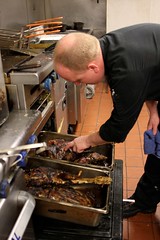
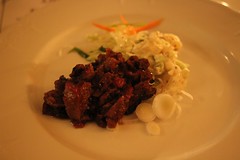
5. Kentucky Bourbon dinner at Big Jones. I’ve always liked Big Jones but, you know, it’s easy to like southern food, doesn’t mean you think it’s great great. Where chef Paul Fehribach soars is in his regular historical dinners, which recreate recipes from specific places and eras— doing what Next does in a single night. This 1830s Kentucky bourbon dinner was fascinating for serving things people would be afraid to eat now (calves’ foot jelly, which was pretty wonderful, actually), things that tasted more like honest home food than restaurant food (mutton barbecue), a door opened into another world that was completely unlike anything else on our food scene this year.


4. Anise hyssop and others at EL Ideas: “I gathered that this is a problem he’s had with some local critics, too— not being sure his restaurant is real enough and serious enough to be worth the investment, of time or money… Let me cut to the chase and say that you have nothing to fear and a lot to anticipate excitedly from EL Ideas. If it’s not a “real” restaurant, then too bad for real restaurants, because in so many ways it’s a warm and engaging experience like fine dining has often forgotten to be. I didn’t entirely buy Foss’s line of patter about the setup overlooking the kitchen space being cozier and more welcoming and erasing the barriers between the chefs and the diners, but that was, in fact, pretty much exactly what it was, and what it did; even if you don’t leave your seat and wander into the kitchen while they’re working, you have no more distance from the chefs, physically and otherwise, than you do from a friend throwing a barbecue in his backyard.”
3. Nathan Myhrvold’s dishes at the Charlie Trotter 25th anniversary dinner. Well, here’s the exception to my general theme. As much as I’ve enjoyed molecular tricks in the past, Myhrvold’s ultrascientific approach took it to a new level— as in the centrifuge-spun caprese salad which was only a tiny shooter of tomato water and separated whey… yet tasted like the most amazing caprese salad you ever ate with an actual fork. It was a real mind bender, to have so much real flavor in such a disembodied form— but it’s not just about tricks; Myhrvold’s pastrami, which happened by some process too complicated for me to recall after a couple of glasses of wine, was utterly delectable as, unmistakably, meat.


2. Publican Quality Meats. Given what’s going on here with housemade sausage and bread and so on, I wanted to love the first round of sandwiches, and I… liked them. None was as good or rich or multidimensional as the one bite of the cocido I had one day, which had the benefit of that more deeply flavorful sausagemaking downstairs. I’m not saying I didn’t go back there a lot, but it wasn’t with quite the rapture that others felt for this place, based on the sandwiches. Then came the chicken parm, and then the PB&L (a pork belly and lamb sausage), and for me PQM hit the magic sweet spot of blue collar food made with artisanal care… and now I would tell anyone that PQM is on the short list of true must-visits in Chicago.

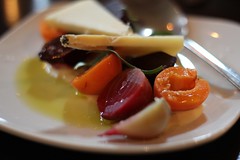
1. Vera. People ask me if I have a favorite restaurant. I don’t, really, because I have to always try new places; I’m not a guy who has a place that he goes back to over and over. But I had a favorite restaurant, once: Rob and Allie Levitt’s Mado. I loved the freshness and simplicity of how they treated things from the farmer’s markets. I loved the spirit of adventure in the air. I knew them and trusted them, and I mourned Mado not being in my life even as I admire what they’ve done next (The Butcher & Larder). And the closest I’ve come since then to feeling the same about a place has been Vera, Mark and Liz Mendez’s restaurant, which is officially a Spanish tapas bar, but to me is just a place that does kind of Mediterranean stuff with whatever’s at the farmer’s market, sometimes makes great things, sometimes makes just pretty good ones, but the great ones are terrific (boquerones, grilled tongue, and whatnot) and everything speaks of simplicity and honesty and directness in its path from the soil (or the sea) to my mouth. It’s my favorite restaurant. I think.
Other things I thought seriously about putting on here, besides Next Kyoto: Next El Bulli (at least what I had of it); Nellcôte for rabbit sausage and Taleggio with green onions and grapes and speck pizza; L2O for the earliest, most delicate courses, like the cauliflower mousse; crispy tripas at La Chapparita; chicken soup with crispy rice at Lao Shanghai; pizza from Armitage Pizzeria; braised escarole at Eataly; fried pickle salad at Stout Barrel House; polenta with pork belly and schweinekopf at Table, Donkey and Stick; fried dino-chicken wing, Golden Palace.
Best Things Eaten in Late 2012 List (click Best Things I’ve Eaten Lately under Categories to see all these lists):

• Grilled langoustines, brussel sprout salad, merguez empanada, seafood moqueca, La Sirena Clandestina
• Red skin mashed potatoes, The Southern
• Fried chicken, Macarthur’s
• Pollo tinga, La Catrina (3658 W. Diversey)
• Maultaschen with chicken consommé, schweinekopf, polenta with roasted bacon, Table, Donkey & Stick
• Mussels with coconut broth, Libertad
• Pastrami hash, Eggy’s Diner
• Doner, Iskender doner, falafel, Zizi’s
• Edwards Surryano ham, both by itself and at Avec
• Lots of things at L2O, almost all on the delicate small piece of fish side, but the desserts are pretty great too
• Greens at Pecking Order
• Grilled sardine, African chicken, Fat Rice
• Gyros, Covo Market
• Ramen at The Aviary
• Ramen at Ginza
Ten best for: 2011 2010 2009 2008 2007 2006 2005 2004 2003
Let me end with a toast to using the internet to share the delight of food and good company; I raise a new Chicago brew I can’t wait to try with Thai food…
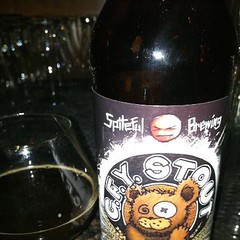


 Posted in
Posted in 




